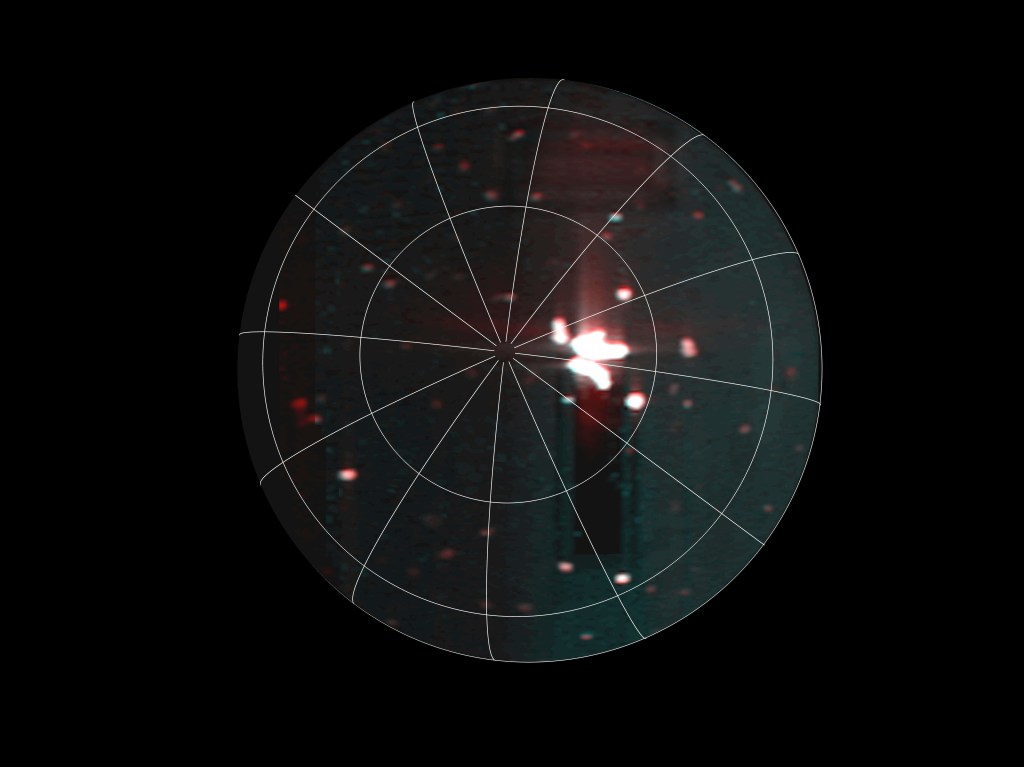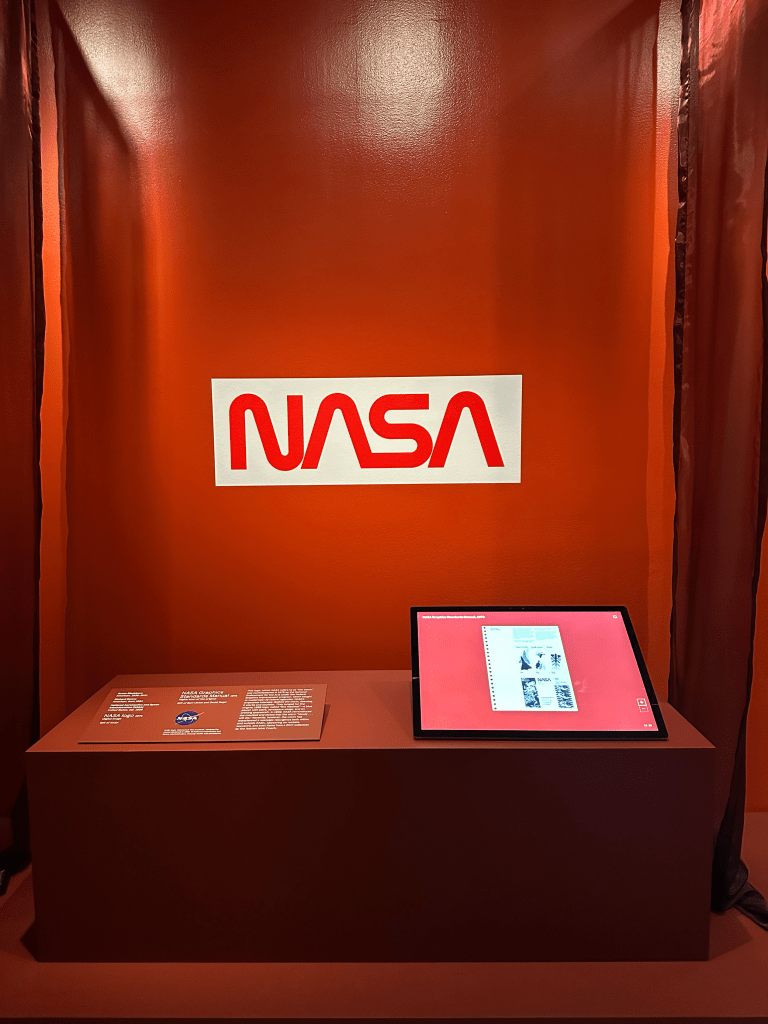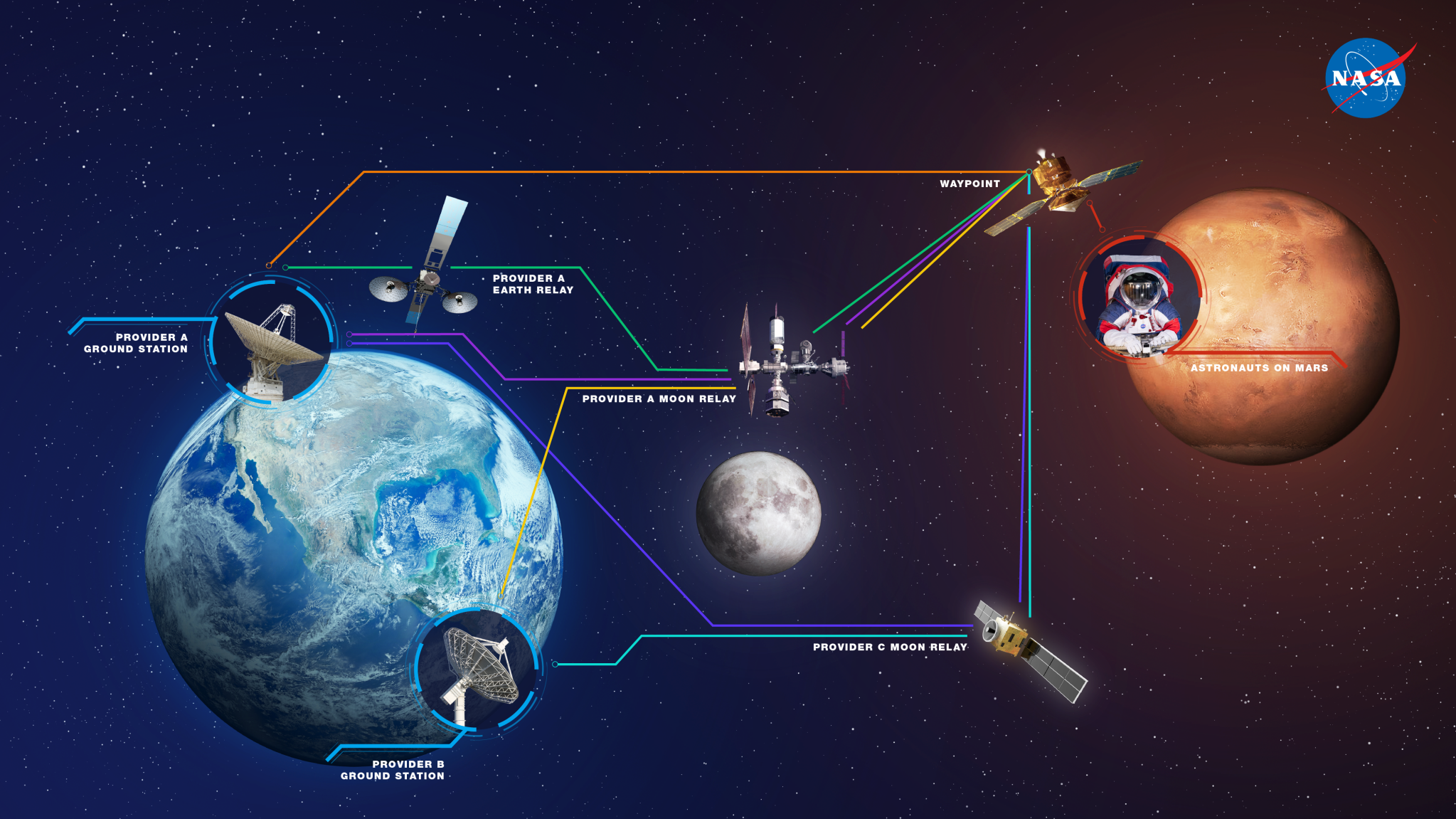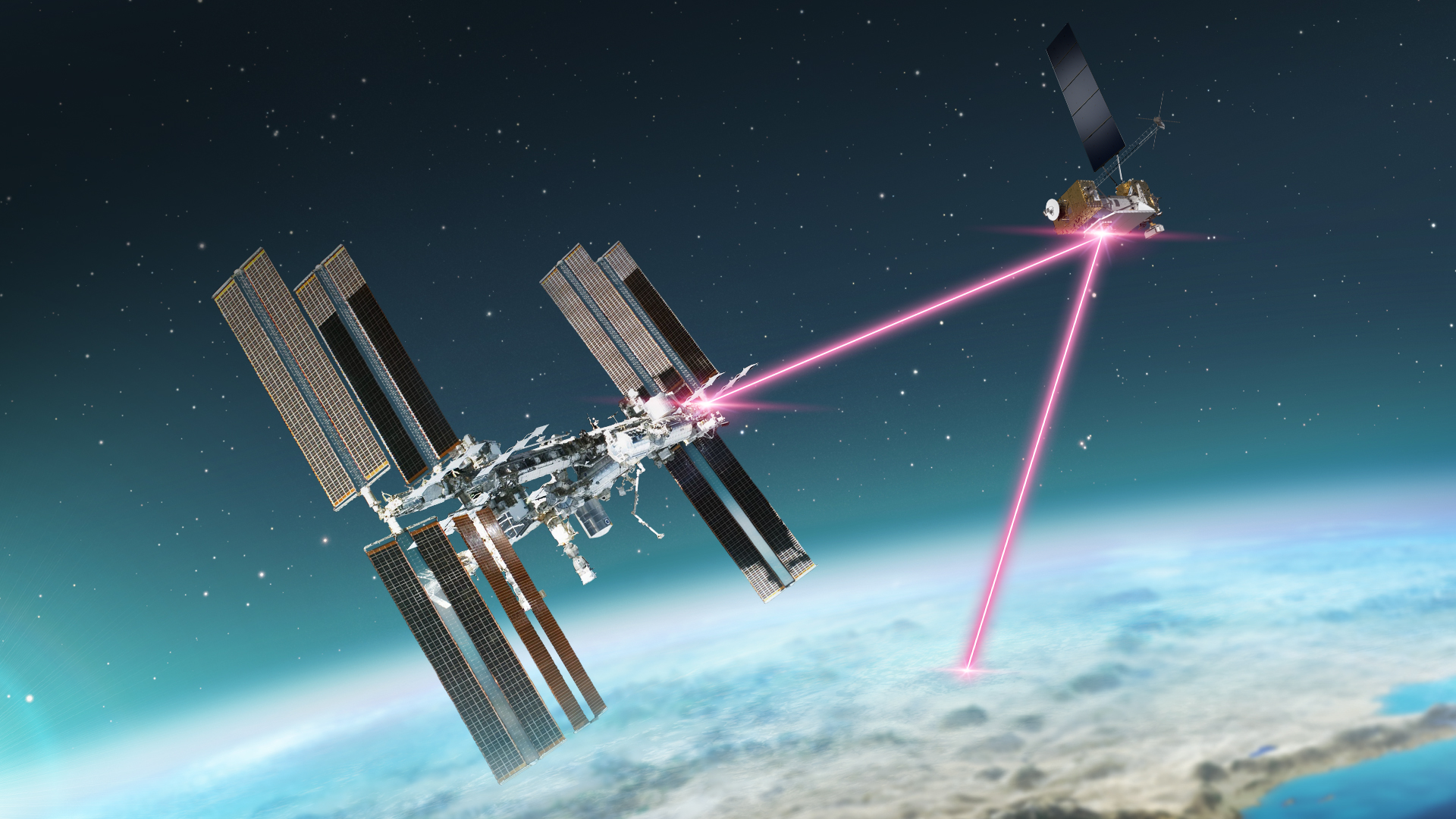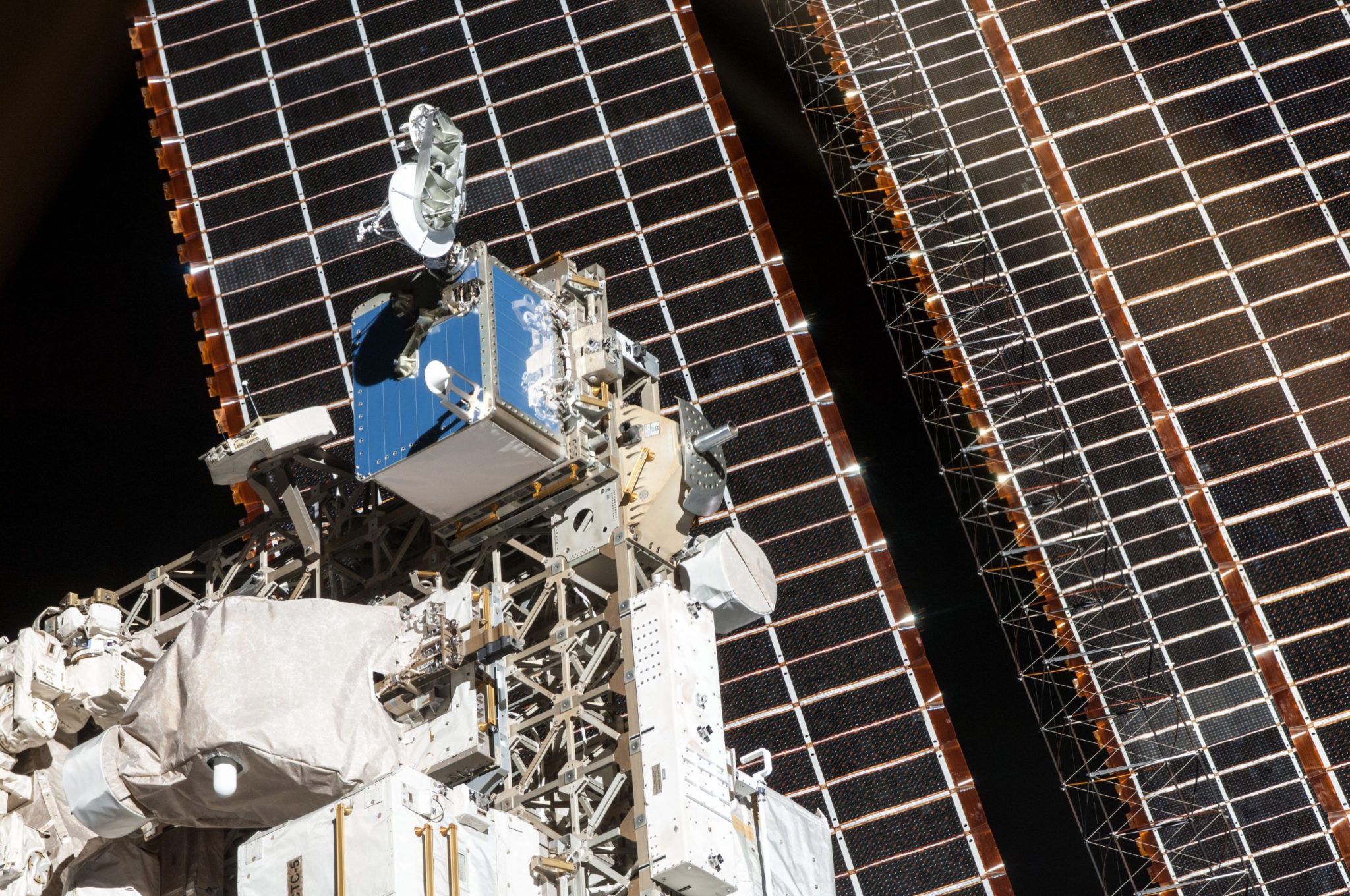Delay/Disruption Tolerant Networking (DTN)
SCaN is developing a set of international standards, collectively referred to as Disruption Tolerant Networking (DTN) standards, to support internetworking in space.
DTN is a suite of standard protocols that uses information within the data stream to accomplish end-to-end data delivery through network nodes. A DTN architecture is a store-and-forward communications architecture in which source nodes send DTN bundles through a network to destination nodes.
Learn more: Delay/Disruption Tolerant Networking
Optical Communications
Optical communication is a form of long distance communication that uses light as a means of transmitting information. Optical communications systems are ideal for missions because they need less volume, weight, and power. Less mass means more room for science instruments, and less power means less of a drain of spacecraft power systems.
SCaN supports a number of optical communications technology demonstration missions, such as the TeraBye InfraRed Delivery (TBIRD) payload, the Laser Communications Relay Demonstration (LCRD) mission, and the Orion Artemis II Optical Communications System (O2O).
Some of the benefits of an optical communications system for space missions include:
- Faster: Higher data rates can enable increased data volume for missions that have been able to generate far more data than they could downlink, or enable new “high definition” instruments that collect larger volumes of data. It’s not that the data is traveling faster with optical communications compared to radio communications. Instead, higher data rate links will enable mission data to be downloaded using shorter contact times, resulting in the use of less onboard spacecraft power and requiring fewer relay terminals and ground sites to support missions. Therefore, the process is sped up.
- Secure: Optical communications terminals use narrower beam widths than radio frequency (RF) systems. They provide smaller illuminated “footprints” that improve security by drastically reducing the geographic area where a communications link can be intercepted/received.
- Lighter: Optical communications flight terminals reduce user Size, Weight, and Power (SWAP) because they are smaller, lighter and require less power than traditional RF communications equipment. Reducing the SWAP of onboard communications systems can provide the host mission with increased capacity for science instruments or enable cost savings.
- Flexible: Optical communications open the possibility of building low-cost ground segments (for low Earth missions) that can be located at mission sites or data centers, enabling lower costs by decreasing ground data transmission costs and consolidating certain mission operations functions.
Learn more: Optical Communications
Software Defined Radio (SDR)
The first radio was invented late in the nineteenth century. From its invention until now, radios have undergone many technological advances. Conventional or legacy radios are not programmable. They are designed for one fixed configuration. They are built to produce a single waveform at a specified frequency. Conventional radios often also have limited tuning options and fixed data rates. While some conventional radios carry multiple types of data, they are incapable of adapting to new waveforms. To make changes on these legacy radios, the radio would physically need to be changed. Once a radio is out in space, that task becomes near impossible to accomplish. These limitations created a number or needs for improved communication in space.
NASA engineers needed radios to be more flexible, adaptable, and evolvable. In the late twentieth century, a new type of radio was developed that would be able to meet those very needs. Software Defined Radios (SDR) are a type of reconfigurable radio in which some or all of the physical layers of functionality are implemented in software or firmware. In the future, more and more missions will be utilizing SDR technology. The Mars Science Laboratory (MSL) currently employs second generation Software Defined Radios (SDRs), while the SCAN Testbed has third generation SDRs.
SCaN Testbed
The SCAN Testbed project tested various software defined radio technologies on the International Space Station.
After seven successful years, and more than 4,200 hours of testing, the SCAN Testbed was decommissioned June 3, 2019 as it burned up in the trunk of SpaceX CRS-17 upon reentry into Earth’s atmosphere.
Launched on July 20, 2012, on a Japanese H-IIB Transfer Vehicle, the SCaN Testbed (STB) was installed on the International Space Station to provide an on-orbit, adaptable software-defined radio (SDR) facility with corresponding ground and operational systems. The SCaN Testbed led groundbreaking efforts to champion use of software defined radios for space communications.
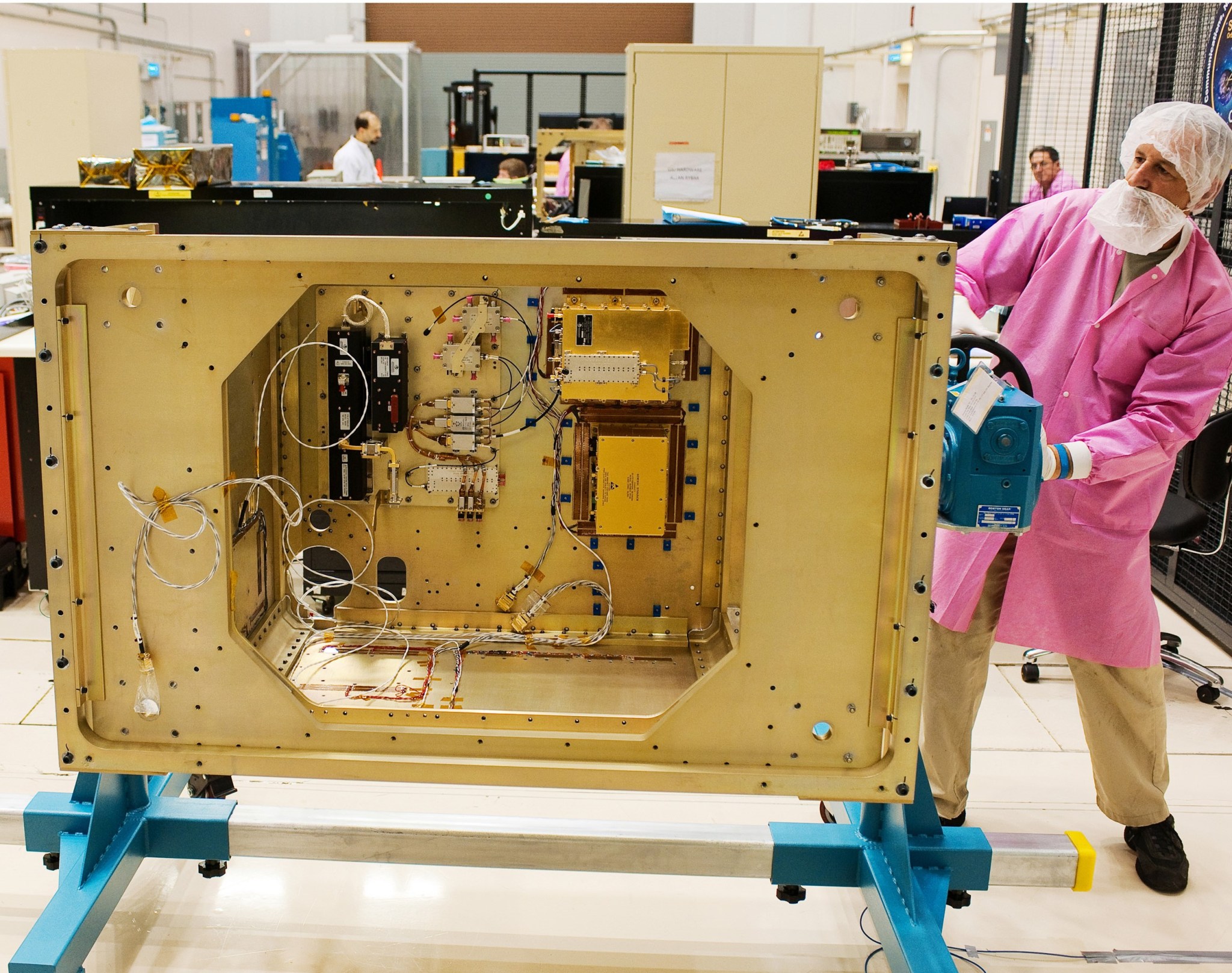
Operations
During its seven years on the International Space Station, STB was able to demonstrate routine reconfiguration of radios in space 888 times, challenging the perception that even a single reconfiguration was a significant mission risk. The testbed successfully established the first Ka-band full duplex space transceiver, which is now a R&D 100 award winning technology and a successful commercial product line. This enabled STB to validate Ka-band performance of NASA’s TDRS satellites K, L, and M, as well as test many communication system upgrades on the ground for projects such as User Service Subsystem Component Replacement (USS-CR) and Space Network Ground Segment Sustainment (SGSS). STB also developed and contributed 6 radio waveforms, or reusable software components, to the Space Telecommunications Radio System (STRS) repository, allowing future missions seamless reuse of prior software investments.
Technology Advances
The SCaN Testbed paved the way for many firsts in communications and navigation technology. It was the first to receive the Global Positioning System (GPS) Civil Navigation Message (CNAV) in space in June 2013. In 2018, STB became the first in-space user of the European Galileo E5A navigation signal, demonstrating the capability for merging Galileo and GPS to precisely determine orbits of spacecraft. The Testbed performed revolutionary study into cognitive communication techniques in 2015, demonstrating the ability for real-time adaptive link control; in 2018, it performed the first-ever demonstration of an adaptive space link controlled entirely by an artificial intelligence algorithm. These experiments enabled demonstrations of automatic communication service scheduling, or User Initiated Service, which allowed STB to request high-rate communications services in near real time, a significant improvement over the prior 3+ week turnaround time.
2019 Decommissioning
After seven successful years and more than 4,200 hours of testing, NASA’s SCaN Testbed was decommissioned June 3 as it burned up in the trunk of SpaceX CRS-17 upon reentry into Earth’s atmosphere. STB’s accomplishments have increased the trust that missions place in software defined radio technology, and demonstrated multiple mission use cases for the benefits of radio reconfiguration in space.
The testbed also provided valuable insights that NASA’s Cognitive Communications Project will use to increase a respective mission’s capabilities and a communications system’s resiliency by merging SDR technology with machine learning, networking and automation.

